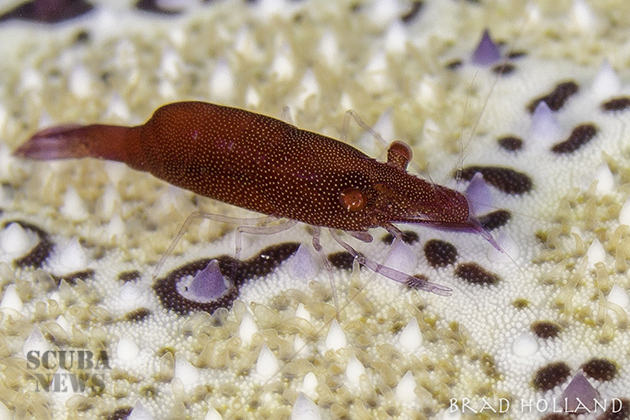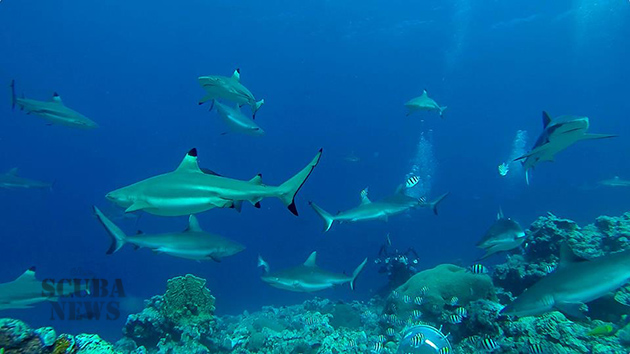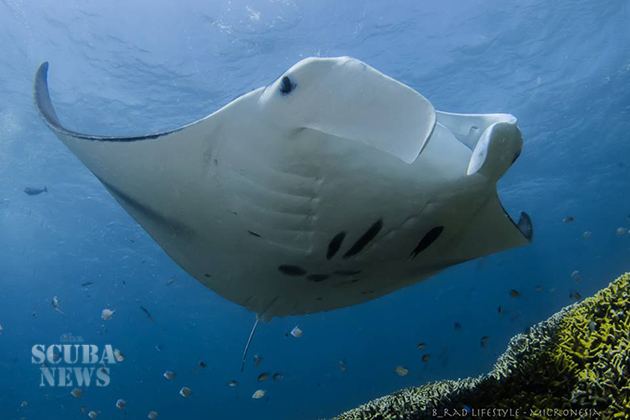
Photos by Brad Holland
This brief report necessarily requires a disclaimer, to the effect that its writer is not neutral in relation to the subject at hand.
To be more precise, after 35 years of being an activist for marine conservation, 14 of which diving around the world after a late start in life, dipping my carcass in the waters of eleven nations, I finally found a place where I always long to go back to. A place so special that I ended up getting married there. This place is Yap, one of the last true paradises of the Pacific where mass tourism and relentless consumerism didn´t get a grip yet; a place truly reserved for the lucky few who learn about it and realize it´s just a fifty-minute flight from celebrated Palau.

Photos by Brad Holland
Located roughly between Japan and Papua New Guinea and encompassing a vast maritime jurisdiction, in which more than 600 islands ensure sovereign rights over 2,600,000 square kilometers of the Tropical Pacific, the Federated States of Micronesia is a mosaic of biodiversity only comparable to its southwestern neighbor, the Coral Triangle. The State of Yap is part of this federation, governed from a coral lagoon with four main islands named as the State and where approximately 8,000 people live.

Photos by Brad Holland
There are several reasons for discerning travelers to be attracted to Yap, beginning with its unique culture, of which the most visible aspects are in the men´s meeting houses dominating the landscape by the traditional settlements; the stone paths linking villages, some of it older than Christ, but still in use and open for visitors to walk; and, of course, the famed Rai or stone money, large stone disks chiseled from quarries in Palau, some 400 Km away, and brought home in fragile sailing canoes! Largely spared the worse aspects of “civilization”, the people of Yap maintain and celebrate their culture, including the most enthralling traditional dances, performed regularly at local ceremonies and also for visitors, and a political system which values the local clan leaders.

Photos by Brad Holland
This much notwithstanding, most foreign visitors to Yap do come looking for its unique diversity of marine life, crowned by the State´s flagship species: the manta ray.
There´s no doubt that the resident population of reef mantas (Manta alfredi, at least until taxonomists decide to turn manta names around again) are the star attraction. More than 100 mantas live year-round in the coral lagoon and its surrounding crystal-clear seas, and can be easily seen on a daily basis. During the whole year, cleaning stations at shallow sites such as Goofnuw and Stammtisch allow visitors to spend long periods underwater in the company of several of these amazing animals, which approach specific coral spots to be pampered by the beneficial services of cleaner wrasse and other fish which take out parasites and bits of flesh from wounds, thus ensuring the mantas´ good health. At these sites they also exhibit great curiosity towards divers, hovering above us while seemingly enjoying the feel of our air bubbles rolling up their bellies. Both the curiosity and grace of the Yapese mantas make us question the widely held belief about the low intelligence of fish, which in this case at least seems to be very wrong indeed.

Photos by Brad Holland
Besides the year-round traffic to and fro cleaning stations, the mantas of yap also offer the bewildering performance of the “manta trains” seen along the coral lagoon channels, especially at Mi´l, during the months from December to April. During this period they chase one another as part of their mating ritual. Manta pups have not been seen in yap, but the resident nature of the population, confirmed by photo-identification studies undertaken by researcher Julie Hartup from the Manta Trust, means that they are most likely born around the Yap atolls, fully protected by a Manta Ray Sanctuary established in 2008 and which encompasses some 21,349 sq. km around 16 main islands and atolls and 145 islets in Yap State waters.

Photos by Brad Holland
Undoubtedly the mantas take center stage, but divers coming all the way to Yap will find that it has much more to offer, Although everybody wants to do the first morning dive with the mantas, the plethora of dive sites available to quench our thirst for saltwater ensures that there´s always much more to see. The channels, bommies, platforms and walls of coral are in excellent state, having been spared from previous bleaching events which plagued vast areas of the Pacific but for some (oceanographic?) reason skipped the region where Yap sits.

Photos by Brad Holland
There are many unique sites, but two merit a special mention: Vertigo, where there are always humungous numbers of gray and blacktip reef sharks waiting for the divers and the tuna head the divemaster conveniently brings to the chickenwire cage at the base of the mooring cable (silvertips and silkies are also seen, and eventually hammerheads linger in the deepest parts of the outer reef on the other side of the island, early in the morning); and Rainbow Reef, this one a mere three minutes´ boat ride from the Manta Ray Bay Resort/Yap Divers pier, and where you dive while the sun sets to wait for the cautious, agile and mesmerizing mandarinfish to leave their coral refuge and hover to mate in front of our masks – true hummingbirds of the sea. Reputedly rainbow Reef harbors the largest colony of mandarinfish in the world, and photographers deem these as the tamest to picture. To this diver, they are as alluring and enough of a reason to visit Yap as the gigantic mantas.

Photos by Brad Holland
It is mind-boggling to learn that this diving Mecca was born out of the efforts of a single man, but that´s exactly how it all began. Texan Bill Acker, owner of Manta ray Bay Resort & Yap Divers, first set foot on Yap in 1976 as a US Peace Corps volunteer. Not long after he married a local beauty, Patricia, and in 1986, after a visit by Australian military personnel who taught him to dive, decided to start a dive business in parallel with his “actual” job at the port of Yap – according to him, just a stunt to help pay for the beer required for his and his friends´ weekend fishing forays. The incredible regularity of manta dives, however, made Yap Divers famous around the world. Nowadays, Bill, Patricia and their welcoming family manage the Manta Ray Bay Resort, where the dive shop is located and which boasts 35 world-class rooms, out of the 100 existing rooms in the whole island. Besides having extreme attention to their guests´ comfort, the Ackers are vigorous conservationists, had a pivotal role in getting the Yapese Manta Ray Sanctuary – a first worldwide – established, and are continuously striving to improve on the resort´s sustainability.
Article courtesy of José Truda Palazzo, Jr – Photos by Brad Holland.







